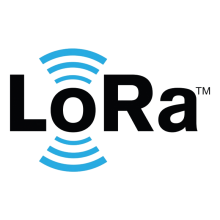
Deployment/Frequency Band(s)
Channel Bandwidth(s)
DL Multiplexing
UL Multiplexing
DL Rate (Peak)
UL Rate (Peak)
Duplex Mode
Modulation
LoRa® is a proprietary physical layer wireless protocol developed by US semiconductor corporation Semtech, designed to facilitate low power, low data rate communications in the unlicensed ISM bands between 137 and 1020 MHz.
Unlike other IoT standards such as NB-IoT and LTE-M which are constructed as national networks, LoRa is most commonly implemented on an ad-hoc basis with companies building local or regional coverage areas as needed. LoRa networks are constructed in a similar manner to traditional mobile and wireless networks, where a radio transmitter+antenna unit is installed on a tower or tall structure. Additional transmitters are added and linked together through an ordinary backhaul network, to form one contiguous network.
LoRa® is the physical layer or the wireless modulation utilised to create the long range communication link. Many legacy wireless systems use frequency shifting keying (FSK) modulation as the physical layer because it is a very efficient modulation for achieving low power. LoRa® is based on chirp spread spectrum modulation, which maintains the same low power characteristics as FSK modulation but significantly increases the communication range. Chirp spread spectrum has been used in military and space communication for decades due to the long communication distances that can be achieved and robustness to interference, but LoRa® is the first low cost implementation for commercial usage.
LoRa® vs LoRaWAN
LoRaWAN™ defines the communication protocol and system architecture for the network while the LoRa® physical layer enables the long-range communication link. The protocol and network architecture have the most influence in determining the battery lifetime of a node, the network capacity, the quality of service, the security, and the variety of applications served by the network.
Advantages
The advantage of LoRa® technology compared to other modulation solutions is good radio-frequency over long distances while power consumption is at a minimum. LoRa® is based on spread spectrum modulation, whose properties include high immunity and, among other things, the small effect of reflections and diffraction on the signal. The signal received by the spread spectrum technology known from mobile telephony technology can be identified below the noise level. LoRaWAN communication can be single or bi-directional and it is divided into different frequency channels and speeds. The choice of data transfer rate depends on the distance between the sensor and the central network server and the amount of data. Most commonly, the LoRaWAN network has a data transfer rate of 0.3 to 50 kb/s. Typical data transfer rates are a few dozen bytes.
LoRa Device Classes
Sensors and terminals with LoRa® technology are available for a variety of purposes worldwide. There are applications for controlling street lighting to observe the discharge of waste containers. Terminals are available for different frequencies and can be customised to their intended use. Terminal equipment can be divided into three different categories.
- Class A: is bidirectional communicating and each transmission is followed by two short reception windows. The transmission time can be defined. It is based on the ALOHA-type protocol where the terminal sends the packet when it needs it. A class A terminal is the least power consuming because its communication with the server is set to the minimum. It only waits for the server to receive the message when it has sent a message to it.
- Class B: the terminal is bidirectionally communicating and has a scheduled reception sites. As an addition to the A-Class random transmission window, there is an additional timed reception window in category B devices. The terminal receives a time-synchronised Beacon message from the router and then opens its own reception window. Therefore, the server also knows when the terminal is awake.
- Class C: terminal is bidirectional and has a maximum number of reception points. The Class C device receives almost continuously. The reception window closes only when the terminal itself transmits.
IoT Frequency Bands
The below chart depicts the number of active networks by operating frequency band. Note that these data are live and may change unexpectedly as we work to complete the database.
IoT Networks
There are 10 networks using this technology recorded.